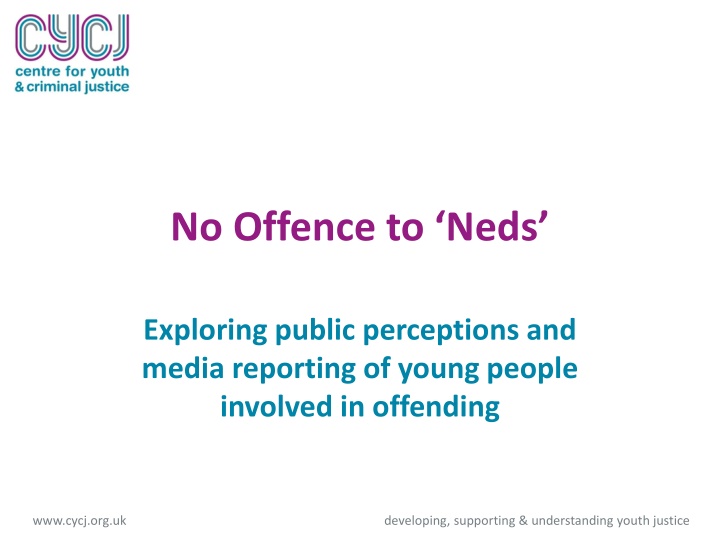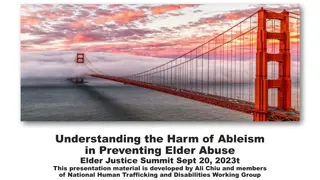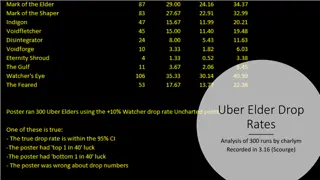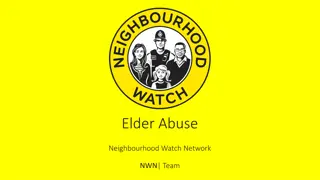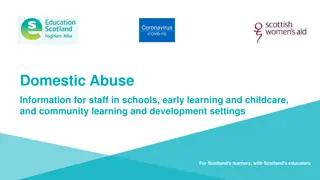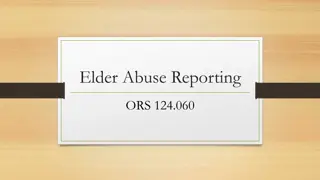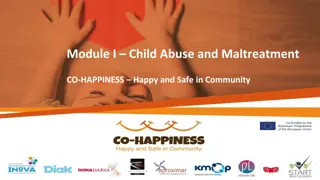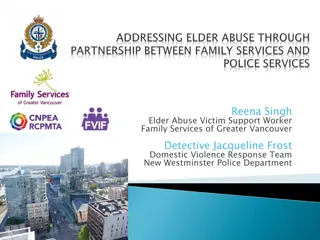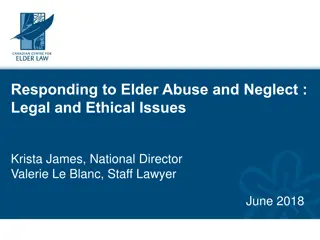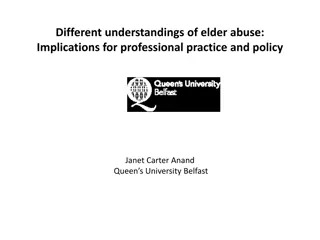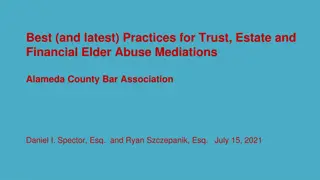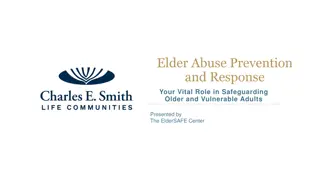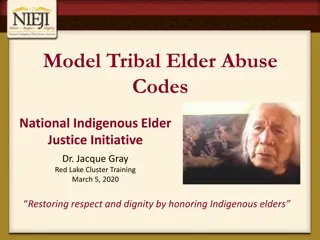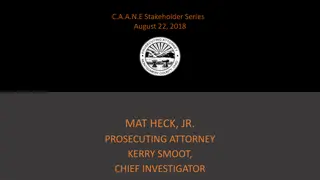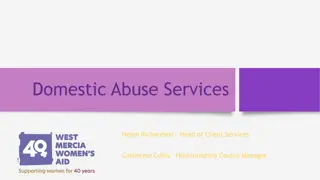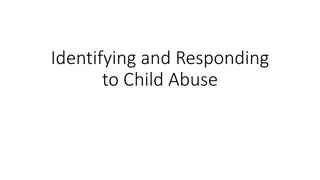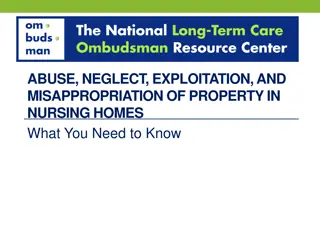Strengthening Community Support Against Elder Abuse
Presenter information, recognizing elder abuse, understanding its forms & causes, and how to prevent it through social supports. Types of abuse, signs to look for, and fostering a protective society for elderly individuals.
Download Presentation

Please find below an Image/Link to download the presentation.
The content on the website is provided AS IS for your information and personal use only. It may not be sold, licensed, or shared on other websites without obtaining consent from the author.If you encounter any issues during the download, it is possible that the publisher has removed the file from their server.
You are allowed to download the files provided on this website for personal or commercial use, subject to the condition that they are used lawfully. All files are the property of their respective owners.
The content on the website is provided AS IS for your information and personal use only. It may not be sold, licensed, or shared on other websites without obtaining consent from the author.
E N D
Presentation Transcript
No Offence to Neds Exploring public perceptions and media reporting of young people involved in offending www.cycj.org.uk developing, supporting & understanding youth justice
Youth crime in Scotland The vast majority of young people do not get involved in offending behaviour 95.3% SPPF, 2013; GRO(S), 2012 www.cycj.org.uk developing, supporting & understanding youth justice
Youth crime in Scotland 20,000 17,641 18,000 16,471 16,000 14,000 11,805 Youth crime has steadily fallen since 2006/07 12,000 10,000 8,000 6,000 3,636 4,000 2,000 0 SCRA (2013) www.cycj.org.uk developing, supporting & understanding youth justice
Youth crime in Scotland 90000 78572 80000 69277 70000 56041 60000 52615 Youth crime has steadily fallen since 2006/07 50000 43117 40000 30000 20000 10000 SPPF (2013) 0 2008-09 2009-10 2010-11 2011-12 2012-13 www.cycj.org.uk developing, supporting & understanding youth justice
Youth crime in Scotland 0% -5% -4% -10% -15% Youth crime has fallen at a faster rate that adult crime -20% -45% -25% -30% -35% -40% -45% -50% SPPF (2013) youth adult www.cycj.org.uk developing, supporting & understanding youth justice
Youth crime in Scotland The majority of youth crime involves petty or nuisance crime violence Indecency Dishonesty SPPF (2013) Vandalism etc. Drugs/other crimes Petty offences www.cycj.org.uk developing, supporting & understanding youth justice
Perceptions of Crime 76% of the general public perceive crime in their area to have stayed the same or reduced in the past two years 76% SCJS (2014) www.cycj.org.uk developing, supporting & understanding youth justice
Perceptions of Crime However you could also say that 85% of the public think crime has stayed the same or increased in the past two years Adults overestimate their likelihood of being a victim of crime (i.e. burglary 6x overestimated) 11% SCJS (2014) www.cycj.org.uk developing, supporting & understanding youth justice
Perceptions of youth crime In 2004, 60% of respondents to the Scottish Social Attitudes Survey think that young people s behaviour was worse than it was in the past 69% thought that youth crime was higher than a decade ago Up to two-thirds of respondents thought that various types of youth crime-related problems (groups of young people hanging around; vandalism etc.) were common in their area www.cycj.org.uk developing, supporting & understanding youth justice
Perceptions of Crime Studies tended to find a perception that crime was increasing even when it was falling Ipsos MORI (2006) survey of 1001 respondents: young people were perceived to commit 47% of crimes (on average) (In Scotland in 2012/13 the actual proportion was 16%) www.cycj.org.uk developing, supporting & understanding youth justice
Reasons behind the perceptions? Personal experience of crime (the risk of being a victim was 16.9% in 2012/2013) Contact with young people: In SSA 2004 biggest concerns were framed as either a lack of opportunities for young people or young people hanging around around depending on contact www.cycj.org.uk developing, supporting & understanding youth justice
Reasons behind the perceptions? Media: most common sources of crime information in CYCJ survey were: Newspapers (100%); TV News (73%). Sources of information about youth crime (Hough and Roberts, 2004) Media 64% Crimes committed against me or people I know 18% What other people say 16% Personal observation 9% Government statistics 5% www.cycj.org.uk developing, supporting & understanding youth justice
The role of the media? print media influences public opinion on crime trends by increasing coverage of certain crimes disproportionately to the amount of crime in a community Carli (2008) heavy media consumption had statistically significant relationships with fear of crime and punitive attitudes Boda and Szab (2011) www.cycj.org.uk developing, supporting & understanding youth justice
The role of the media? Certainly media reporting can paint a negative picture of young people www.cycj.org.uk developing, supporting & understanding youth justice
Media Reporting However, does the media get a bad press ? Analysis of 6 papers across: Glasgow; Edinburgh and Aberdeen Compared headlines relating to young people from a six month period in 2006, to the same six-month period in 2013 www.cycj.org.uk developing, supporting & understanding youth justice
Media Reporting: 2006 Almost half of all headlines painted a negative picture of young people (46.6%) Teen mob sprays seat at museum EE, July 22 2006 Tougher action needed on neds ET, Dec 4 2006 Only 17.2% of headlines outlined young people doing something positive Reward for young volunteers P&J, Sept 1 2006 The rest were either neutral (15.2%) or reported the young person to be a victim of crime or other circumstances (21%). Teenagers in China to sit Highers Scotland on Sunday, Sept 3 2006 www.cycj.org.uk developing, supporting & understanding youth justice
Media Reporting: 2013 There was a notable decrease in headlines that painted a negative picture of young people (28.9%, compared to 46.6% in 2006) Teenager admits travel fraud charges The Herald, Aug 17 2013 Gang of 40 young thieves causes havoc P&J, Sept 20 2013 There was an increase in headlines that describe young people as a victim of crime or circumstance (31.1%, compared to 21%) Criminal records ruin young lives Scotland on Sunday, Nov 3 2013 There was an increase in headlines that were neutral about young people (22.5% compared to 15.2%) Referendum drive to get young voters ET, Oct 1 2013 www.cycj.org.uk developing, supporting & understanding youth justice
Media Reporting: 2013 However, only 17.4% of headlines outlined young people achieving something positive (compared to 17.2% in 2006) Teenagers march in support of their deported classmates The Herald, Oct 18 2013 Young choir raises 450 for charity EE, Dec 27 2013 www.cycj.org.uk developing, supporting & understanding youth justice
Media Reporting 2006 2013 768 thug 48 (6.3%) knife 10 (1.3%) gang 6 (0.8%) yob 0 (0%) ned 1 (0.1%) 1,088 thug 103 (9.5%) knife 32 (2.9%) gang 25 (2.3%) yob 9 (0.8%) ned 9 (0.8%) www.cycj.org.uk developing, supporting & understanding youth justice
What is behind the change? Less stories about young people in general? Less crime? Changes in the media? Societal changes? www.cycj.org.uk developing, supporting & understanding youth justice
Conclusions? Whatever the reason these are positive changes. However, given that less 5% of young people were involved in any level of offending is this still a fair reflection of young people in the media? www.cycj.org.uk developing, supporting & understanding youth justice
